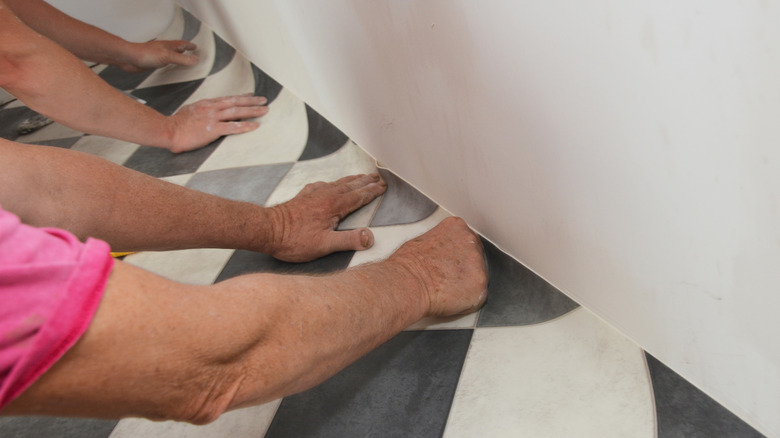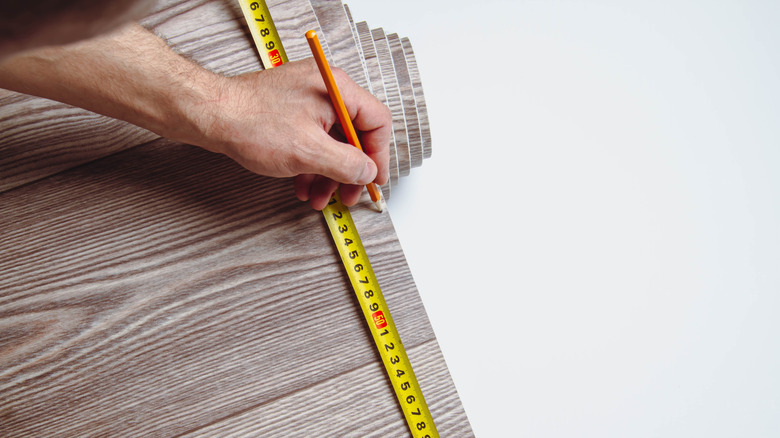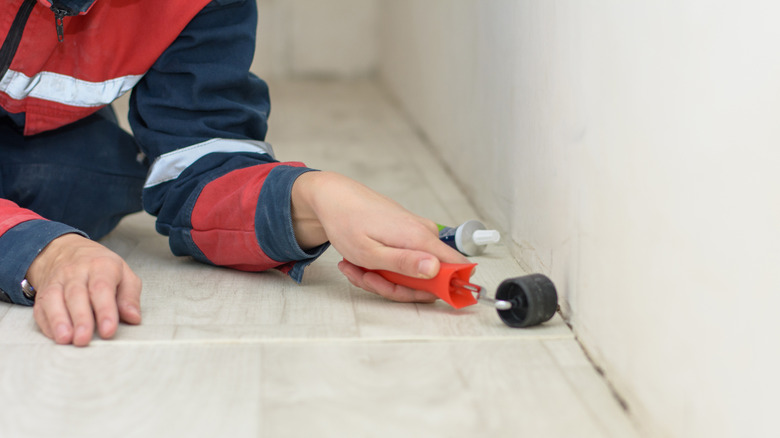Installing Your Own Linoleum Floor? Signs It's Time To Call In The Pros
Linoleum flooring is making a comeback! Inexpensive, durable, and available in a wide range of styles, it's a great way to update your kitchens and bathrooms without blowing your budget. Eager DIYers may be encouraged by the fact that linoleum is among the easiest flooring options to install. But according to Paul Henthorn, owner of Slaughterbeck Floors, if you want a flawless linoleum installation but are dealing with damaged or uneven subfloors, complex seams or patterns, or high-traffic areas where long-term durability really matters, you're better off calling in a pro.
"Just like hardwood, linoleum needs to acclimate in the environment it will be installed in for at least 48 hours to prevent expansion or contraction after installation," Henthorn told House Digest during an exclusive interview. He said professionals will start your project by keeping each linoleum roll upright and in a spot where the temperature is a steady 65 degrees Fahrenheit or higher. While your linoleum is acclimating, they'll prepare your subfloors. "Leveling the floor will add to the longevity of your flooring," Henthorn explained, adding that subfloors must be totally "clean, dry, smooth, and level" prior to installation.
Once the subfloors are adequately prepped, a professional will dry-fit the linoleum to your space. "It's practically a given that measuring, cutting, and aligning the material in the correct pattern and direction is critical," Henthorn said. "Pattern match can make or break a job." Even if your subfloors are pitch perfect, if your room shape or linoleum design requires complex cuts or seams, it's best to call in a professional. The flooring expert cautioned that "a poorly leveled floor will fail very fast."
Professionals know exactly how much linoleum flooring you need
According to Henthorn, there are a lot of things to consider before installing linoleum flooring. "Ensure the right amount is purchased, with at least 10% overage," Henthorn said during his exclusive interview with House Digest. Although it's possible to figure out the right quantities on your own, a professional will know exactly how much linoleum you need to get the job done. They may also benefit from trade pricing that brings down the per roll cost. "Even if purchasing from the same manufacturer, ensure you only use material from the same batch/dye lot," he suggested. If you don't, Henthorn warned you'll see visible shade differences once your linoleum is installed. He added that the batch number will be clearly marked on the packaging. While DIYers may not realize or remember to double-check dye lot numbers, it's second nature to professional installers.
The average cost to install a linoleum floor ranges between $650 and $5,000. Despite its relatively low price compared to tile or hardwood materials, you may be gulping at the thought of buying 10% more than your room measurements indicate. But Henthorn said buying too little linoleum is a common DIY mistake. "Many amateur installers will not accommodate shrinkage of the materials," he explained. "Linoleum will shrink in length and expand in the width when placed into wet adhesive." Professional installers are familiar with this process and are in a better position to gauge exactly how much shrinkage is likely, especially in larger areas over 20 to 25 feet.
Choosing the wrong adhesives or techniques are common DIY mistakes
Although it can be an achievable DIY project that dramatically improves the look and function of your favorite rooms, there are even more DIY linoleum installation mistakes you should avoid. "Skipping acclimation is the first step that is often overlooked, which can lead to buckling or shrinkage," Henthorn told House Digest during his exclusive interview. Things can also quickly go wrong when a DIYer attempts to lay linoleum over radiant heating or in complex spots like narrow hallways or stairs that require advanced tubing techniques to avoid pinching or creasing the linoleum. Flooring professionals will be much more familiar with which products will or won't work in your specific situation.
Choosing the right flooring adhesive and making sure it's 100% wet when linoleum is laid down is equally important. "If any portion of the adhesive dries, there will be imperfections," Henthorn explained, adding that linoleum needs to stay in firm contact with the adhesive as it cures. While DIYers may find themselves wondering which water- or solvent-based adhesive is best for their situation or struggling to lay linoleum before it dries, professionals will know exactly what product works best with the selected flooring and how to apply it.
Finally, Henthorn said professionals will have the heavy-duty rollers that are absolutely crucial to a long-lasting linoleum installation. "You can never roll too much," he emphasized, before adding that professionals will typically use both a three-section wall roller on the primary sections of flooring, along with a steel seam roller anywhere the full weight of the larger roller can't reach. Whether you DIY or call in a professional, Henthorn has one piece of advice: "Roll aggressively, immediately, and thoroughly."


